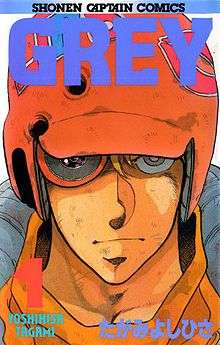Grey (manga)
| Grey | |
 The cover of the first volume of Grey | |
| グレイ (Gurei) | |
|---|---|
| Genre | Dystopia, Sci-fi |
| Manga | |
| Written by | Yoshihisa Tagami |
| Published by | Tokuma Shoten |
| English publisher | |
| Demographic | Shōnen |
| Magazine | Monthly Shōnen Captain |
| Original run | 1985 – 1987 |
| Volumes | 3 |
| Anime film | |
| Grey: Digital Target | |
| Directed by | Satoshi Dezaki |
| Studio |
Magic Bus Tokuma Japan Corp. |
| Released | December 13, 1986 |
| Runtime | 73 minutes |
Grey (グレイ Gurei) is a Japanese science fiction manga created by Yoshihisa Tagami that was published in the 1980s.
It was also adapted into an original video animation under the title Grey: Digital Target.
Setting
The world is covered in wastelands that are dotted with numbered "Towns". All Towns are supervised by computers called "Little Mamas" (nodes connected to the world governing super-computer called "Big Mama"); the underprivileged live in the slums and are referred to as "People". One can only become one of the privileged "Citizens" by joining the army and fighting the other Towns' forces, as the Towns are continually at war with one another. Combatants earn 50 credits per mission, plus 30 credits for every enemy killed. Once the total reaches 1000, the fighter's class is increased by one category (starting at F, then going to E, D, C, B and making one's way up to A). The A class guarantees a transfer to the idyllic, legendary "City".
Citizens have numerous advantages over People: in addition to getting out of the ghetto, they do not worry about being beaten up, raped or otherwise victimized. It's this advantage that leads Grey's lover, a girl known as "Lips", to become a Trooper. Her death, during her first and only operation, leads Grey to join the army as well and follow her dream of getting to the City by sheer force of will. Grey soon earns the nickname "Grey Death" for his tenacity on the battlefield and ability to survive when the rest of his comrades are killed. He only accepts orders that keep him alive, and will not kill the resistance fighters that fight against the Town system because they are not worth any points. Sullen and cocky, Grey exists only to survive and kill, in that order.
Grey's sense of loyalty gets him into trouble when he finds out that his field commander, a man that saved his life many times, is lost in the African sector. He abandons Town 303 to go look for him. Along the way, he discovers who and what the resistance fighters are, why the Towns are all different in both military might and how they are run, and what the true secret of "Big Mama" is.
Themes
Grey consistently encounters "dolls" (robots and androids closely resembling humans in behavior and speech), leading to tension between his search for the truth behind the Little Mamas and his reliance on robots to perform menial tasks.
Release
Harlan Ellison wrote the introduction to the Viz Media English Adaptation. In it, he compared Grey to his own type of hard-edged speculative fiction.
OVA
Where the manga stays on a downward spiral of tragedy, a few choices in the anime adaptation provide some hope to Grey and his companions.
Reception
Helen McCarthy in 500 Essential Anime Movies praised the film as being "intelligently written". She stated that "although the animation is dated, this is one of the most poignant and compelling anime ever made", calling it a "bleak yet uncompromisingly courageous view of the individual choices and chances against the system".[1]
References
- ↑ McCarthy, Helen. 500 Essential Anime Movies: The Ultimate Guide. — Harper Design, 2009. — P. 65. — 528 p. — ISBN 978-0061474507
External links
- "Translated Manga Pick of the Month" -(J-pop.com)
- Entry in the Encyclopedia of Science Fiction